 W
WItalian Fascism, also known as Classical Fascism or simply Fascism, is the original fascist ideology as developed in Italy by Giovanni Gentile and Benito Mussolini. The ideology is associated with a series of two political parties led by Benito Mussolini; the National Fascist Party (PNF), which ruled the Kingdom of Italy from 1922 until 1943, and the Republican Fascist Party that ruled the Italian Social Republic from 1943 to 1945. Italian Fascism is also associated with the post-war Italian Social Movement and subsequent Italian neo-fascist movements.
 W
WFascist Italy was the era of National Fascist Party government from 1922 to 1943 with Benito Mussolini as Prime Minister of the Kingdom of Italy. The Italian Fascists imposed totalitarian rule and crushed political and intellectual opposition, while promoting economic modernization, traditional social values and a rapprochement with the Roman Catholic Church. According to Payne (1996), "[the] Fascist government passed through several relatively distinct phases". The first phase (1922–1925) was nominally a continuation of the parliamentary system, albeit with a "legally-organized executive dictatorship". The second phase (1925–1929) was "the construction of the Fascist dictatorship proper". The third phase (1929–1934) was with less activism. The fourth phase (1935–1940) was characterized by an aggressive foreign policy: the Second Italo-Ethiopian War, which was launched from Eritrea and Somaliland; confrontations with the League of Nations, leading to sanctions; growing economic autarky; invasion of Albania; and the signing of the Pact of Steel. The fifth phase (1940–1943) was World War II itself which ended in military defeat, while the sixth and final phase (1943–1945) was the rump Salò Government under German control.
 W
WThe 1922 Turin massacre refers to the attack by Italian Fascists against members of a local labour movement in Turin, Italy, during a three-day terror campaign from 18–20 December 1922, to break the resistance of the labour movement and working class to Fascism.
 W
WThe Acerbo Law was an Italian electoral law proposed by Baron Giacomo Acerbo and passed by the Italian Parliament in November 1923. The purpose of it was to give Mussolini's fascist party a majority of deputies. The law was used only in the 1924 general election, which was the last competitive election held in Italy until 1946.
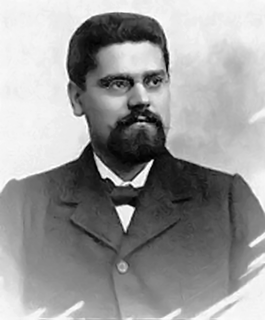 W
WActual idealism was a form of idealism, developed by Giovanni Gentile, that grew into a 'grounded' idealism, contrasting the transcendental idealism of Immanuel Kant, and the absolute idealism of G. W. F. Hegel. To Gentile, who considered himself the "philosopher of fascism," actualism was the sole remedy to philosophically preserving free agency, by making the act of thinking self-creative and, therefore, without any contingency and not in the potency of any other fact.
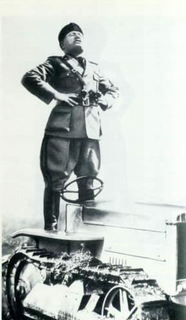 W
WThe Agricultural policy of fascism in Italy was a series of complex measures and laws designed and enforced during Italian Fascism, as a move towards attempted autarky, specifically by Benito Mussolini following the Battle for Grain and the 1935 invasion of Abyssinia and subsequent trade embargoes.
 W
WThe Albanian Fascist Party was a Fascist organization active during World War II which held nominal power in Albania from 1939, when the country was conquered by Italy, until 1943, when Italy capitulated to the Allies. Afterwards, Albania fell under German occupation, and the PFSh was replaced by the Guard of Greater Albania.
 W
WThe Battle for Grain was an economic policy undertaken by the Fascists in Italy during the 1920s as a move toward autarky.
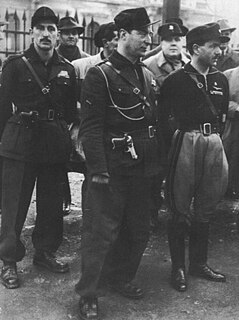 W
WThe Corpo Ausiliario delle Squadre d'azione di Camicie Nere, most widely known as the Black Brigades, was one of the Fascist paramilitary groups, organized and run by the Republican Fascist Party operating in the Italian Social Republic, during the final years of World War II, and after the signing of the Italian Armistice in 1943. They were officially led by Alessandro Pavolini, former Minister of Culture (MINCULPOP) of the fascist era during the last years of the Kingdom of Italy.
 W
WBozner Blutsonntag refers to the events of 24 April 1921 in Bozen. It was the first climax of fascist violence in South Tyrol, a German-speaking province that was annexed by Italy after World War I.
 W
WThe Italian Regency of Carnaro was a self-proclaimed state in the city of Fiume led by Gabriele d'Annunzio between 1919 and 1920. It is also known by its lyrical name in Italian: Endeavor of Fiume.
 W
WChamber of Fasces and Corporations was the lower house of the legislature of the Kingdom of Italy from March 23, 1939 to August 2, 1943, during the height of the regime of Benito Mussolini's National Fascist Party.
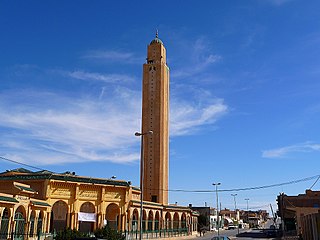 W
WJadu, in other languages also: Giado (Italian) and Gado, is a mountain town in western Libya, in the Jabal al Gharbi District and the Nafusa Mountains.
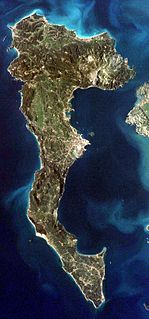 W
WThe Corfu incident was a 1923 diplomatic and military crisis between Greece and Italy. It was triggered when an Italian general heading a commission to resolve a border dispute between Albania and Greece was murdered in Greek territory along with members of his staff. In response, Benito Mussolini issued a severe ultimatum to Greece and, when it was not accepted in whole, dispatched forces to bombard and occupy Corfu. Mussolini defied the League of Nations and stated Italy would leave if it arbitrated in the crisis, and the Conference of Ambassadors instead eventually tendered an agreement favoring Italy. This was an early demonstration of the League's weakness when dealing with larger powers.
 W
WDuce is an Italian title, derived from the Latin word dux "leader", and a cognate of duke. National Fascist Party leader Benito Mussolini was identified by Fascists as Il Duce of the movement since the birth of the Fasci Italiani di Combattimento in 1919. In 1925 it became a reference to the dictatorial position of Sua Eccellenza Benito Mussolini, Capo del Governo, Duce del Fascismo e Fondatore dell'Impero. Mussolini held this title together with that of President of the Council of Ministers: this was the constitutional position which entitled him to rule Italy on behalf of the King of Italy. Founder of the Empire was added for the exclusive use by Mussolini in recognition of his founding of an official legal entity of the Italian Empire on behalf of the King in 1936 following Italy's victory in the Second Italo-Ethiopian War. The position was held by Mussolini until 1943, when he was removed from office by the King and the position of "Duce" was dismantled, while Marshal Pietro Badoglio, 1st Duke of Addis Abeba was appointed Presidente del Consiglio.
 W
WThe Italian colonial empire, known as the Italian Empire between 1936 and 1943, comprised the colonies, protectorates, concessions, dependencies and trust territories of the Kingdom of Italy. The genesis of the Italian colonial empire was the purchase in 1869 of Assab Bay on the Red Sea by an Italian navigation company which intended to establish a coaling station at the time the Suez Canal was being opened to navigation. This was taken over by the Italian government in 1882, becoming modern Italy's first overseas territory.
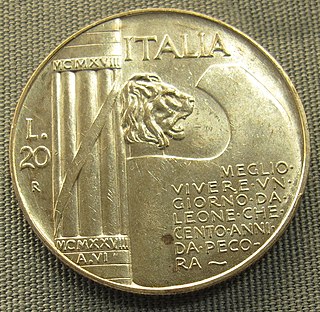 W
WThe Era Fascista was a calendar era used in Fascist Italy. The March on Rome, or more precisely the accession of Mussolini as prime minister on 29 October 1922, is day 1 of Anno I of the Era Fascista. The calendar was introduced in 1926 and became official in Anno V (1927). Each year of the Era Fascista was an Anno Fascista, abbreviated A.F.
 W
WThe expatriate American poet Ezra Pound recorded or composed hundreds of broadcasts in support of fascism for Italian radio during World War II and the Holocaust in Italy. Based in Italy since 1924, Pound collaborated with the fascist regime of Benito Mussolini and expressed support for Adolf Hitler. Written at first for EIAR, and later for a new radio station in the Salò Republic, a Nazi puppet state in northern Italy, the broadcasts contained deeply antisemitic and racist material. They were transmitted to England, central Europe, and the United States, mostly in English, but also in Italian, German, and French.
 W
WThe Italian Fasces of Combat was an Italian fascist organization, created by Benito Mussolini in 1919.
 W
WThe Kingdom of Italy witnessed significant widespread civil unrest and political strife in the aftermath of World War I and the rise of the Far-right Fascist movement led by Benito Mussolini which opposed the rise of the international left, especially the far-left along with others who opposed Fascism.
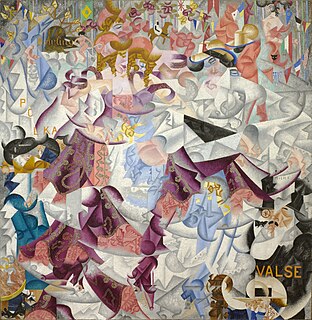 W
WFuturism was an artistic and social movement that originated in Italy in the early 20th century. It emphasized speed, technology, youth, violence, and objects such as the car, the airplane, and the industrial city. Its key figures were the Italians Filippo Tommaso Marinetti, Umberto Boccioni, Carlo Carrà, Fortunato Depero, Gino Severini, Giacomo Balla, and Luigi Russolo. It glorified modernity and aimed to liberate Italy from the weight of its past. Cubism contributed to the formation of Italian Futurism's artistic style. Important Futurist works included Marinetti's Manifesto of Futurism, Boccioni's sculpture Unique Forms of Continuity in Space, Balla's painting Abstract Speed + Sound, and Russolo's The Art of Noises.
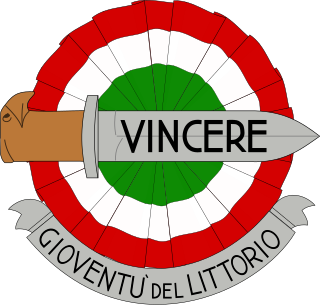 W
WThe Gioventù Italiana del Littorio (GIL) was the consolidated youth movement of the National Fascist Party of Italy that was established in 1937, to replace the Opera Nazionale Balilla (ONB). It was created to supervise and influence the minds of all youths, that was effectively directed against the influence of the Catholic Church on youths.
 W
WThe Grand Council of Fascism was the main body of Mussolini's Fascist government in Italy. A body which held and applied great power to control the institutions of government, it was created as a body of the National Fascist Party in 1923 and became a state body on 9 December 1928. The council usually met at the Palazzo Venezia, Rome, which was also the seat of head of the Italian government. The Council became extinct following a series of events in 1943, in which Benito Mussolini was voted out of the Prime Ministry of Italy.
 W
WThe Italian Regency of Carnaro was a self-proclaimed state in the city of Fiume led by Gabriele d'Annunzio between 1919 and 1920. It is also known by its lyrical name in Italian: Endeavor of Fiume.
 W
WThe Istituto Luce was an Italian corporation, created in 1924 during the Fascist era.
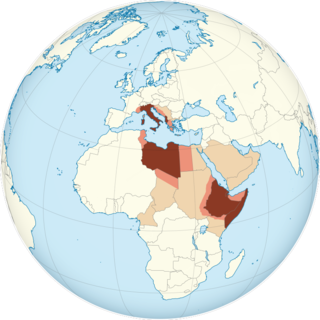 W
WImperialism, colonialism and irredentism played an important role in the foreign policy of Fascist Italy. Among the regime's goals were the acquisition of territory considered historically Italian in France and Yugoslavia, the expansion of Italy's sphere of influence into the Balkans and the acquisition of more colonies in Africa. The pacification of Libya (1923–32), the invasion of Ethiopia (1935–36), the invasion of Albania (1939), the invasion of France (1940), the invasion of Greece (1940–41) and the invasion of Yugoslavia (1941) were all undertaken in part to add to Italy's national space.
 W
WThe Italian Parliament (1928–1939) was the parliament of Italy as it existed following the constitutional reforms enacted after the Italian general election, 1924. It was, in turn, substantially restructured in 1939. This early Fascist-era legislature was a continuation of the bicameral parliament that had existed prior to 1928, though the character, structure and responsibilities of each house were altered to various degrees.
 W
WLa Disperata was the name given to the group of bodyguards who protected Gabriele D'Annunzio. It was taken up in turn by a number of later squadri and fascist military units in Italy between 1921 and 1945.
 W
WRosa Maltoni was the mother of Italian Fascist founder and leader Benito Mussolini, the mother-in-law of Rachele Mussolini and the paternal grandmother of Bruno Mussolini, Edda Mussolini, Romano Mussolini, and Vittorio Mussolini. Maltoni was a Catholic schoolteacher who married Alessandro Mussolini. After Benito, Rosa had three more children, Arnaldo, Laura, and Edvige. She died of meningitis in 1905.
 W
WThe March on Rome was an organized mass demonstration in October 1922, which resulted in Benito Mussolini's National Fascist Party (PNF) ascending to power in the Kingdom of Italy. In late October 1922, Fascist Party leaders planned an insurrection, to take place on 28 October. When fascist troops entered Rome, Prime Minister Luigi Facta wished to declare a state of siege, but this was overruled by King Victor Emmanuel III. On the following day, 29 October 1922, the King appointed Mussolini as Prime Minister, thereby transferring political power to the fascists without armed conflict.
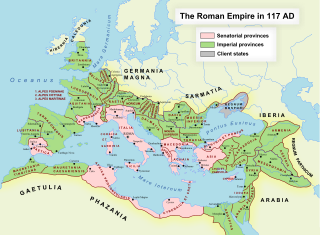 W
WMare Nostrum was a Roman name for the Mediterranean Sea. In Classical Latin, it would have been pronounced [ˈma.rɛ ˈnɔs.t̪rʊ̃mˑ], and in Ecclesiastical Latin, it is pronounced [ˈmaː.rɛ ˈnɔs.t̪rum].
 W
WThe Ministry of Popular Culture was a ministry of the Italian government from 1937 to 1944. It was established by the Fascist government in 1922 as the Press Office of the Presidency of the Council, before being renamed to Press Office of the Head of Government in 1925. In 1934 it became the Secretariat for Press and Propaganda. It became a ministry in 1935 and was given its definitive designation in 1937. During its existence, it controlled most of the literary and radio channels in Italy. It was the Italian analogue of the German Reich Ministry of Public Enlightenment and Propaganda.
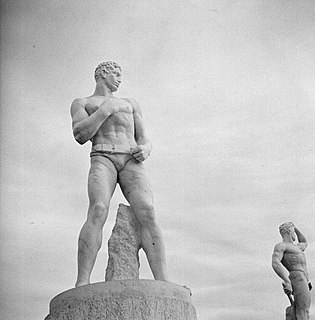 W
WThe model of masculinity under fascist Italy was an idealized version of masculinity prescribed by dictator Benito Mussolini during his reign as fascist dictator of Italy from 1925-1943. This model of masculinity, grounded in anti-modernism and traditional gender roles, was intended to help create a New Italian citizen in a budding New Italy.
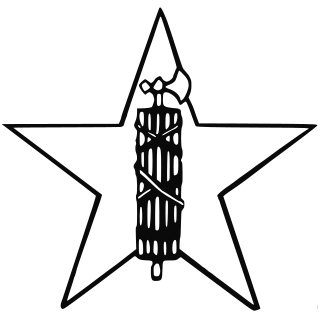 W
WThe National Blocs was a right-wing coalition of political parties in Italy formed for the 1921 general election.
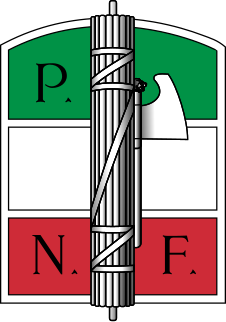 W
WThe National Fascist Party was an Italian political party, created by Benito Mussolini as the political expression of Italian Fascism and as a reorganization of the previous Italian Fasces of Combat. The party ruled the Kingdom of Italy from 1922 when Fascists took power with the March on Rome until the fall of the Fascist regime in 1943, when Mussolini was deposed by the Grand Council of Fascism. It was succeeded, in the territories under the control of the Italian Social Republic, by the Republican Fascist Party, ultimately dissolved at the end of World War II.
 W
WThe National List also known as Listone was a Fascist and nationalist coalition of political parties in Italy put together for the 1924 general election, and led by Benito Mussolini, Prime Minister of Italy and leader of the National Fascist Party.
 W
WThe Italian National Republican Guard was a gendarmerie force of the Italian Social Republic created by decree on December 8, 1943, replacing the Carabinieri and the National Security Volunteer Militia (MVSN). General Renato Ricci appointed as its commandant. Major General Italo Romegialli was appointed vice commandant and Major General Nicolò Nicchiarelli became the chief of general staff.
 W
WOpera Nazionale Balilla (ONB) was an Italian Fascist youth organization functioning between 1926 and 1937, when it was absorbed into the Gioventù Italiana del Littorio (GIL), a youth section of the National Fascist Party.
 W
WThe National Recreational Club was the Italian Fascist leisure and recreational organization for adults.
 W
WThe Ordine Nero was an Italian terrorist fascist group founded in 1974 following the dissolution of the fascist Ordine Nuovo. Between 1974 and 1978, bombings by ON led to a number of woundings and deaths, having orchestrated several deadly bombings and murders including the 1974 Italicus Express Bombing and the 1974 Brescia Bombing.
 W
WThe Organizzazione per la Vigilanza e la Repressione dell'Antifascismo was the secret police of the Kingdom of Italy, founded in 1927 under the regime of Fascist dictator Benito Mussolini and during the reign of King Victor Emmanuel III. The OVRA was the Italian precursor of the German Gestapo. Mussolini's secret police were assigned to stop any anti-fascist activity or sentiment. Approximately 50,000 OVRA agents infiltrated most aspects of domestic life in Italy. The OVRA was headed by Arturo Bocchini.
 W
WPropaganda of Fascist Italy was the material put forth by Italian Fascism to justify its authority and programs and encourage popular support.
 W
WSpazio vitale was the territorial expansionist concept of Italian Fascism. It was defined in universal terms as "that part of the globe over which extends either the vital requirements or expansionary impetus of a state with strong unitary organization which seeks to satisfy its needs by expanding beyond its national boundaries". It was analogous to the German Nazi Party's concept of Lebensraum.
 W
WThe continuation, succession and revival of the Roman Empire is a running theme of the history of Europe and the Mediterranean region. It reflects the lasting memories of power and prestige associated with the Roman Empire itself.
 W
WThe Enciclopedia Italiana di Scienze, Lettere ed Arti, best known as Treccani for its developer Giovanni Treccani or Enciclopedia Italiana, is an Italian-language encyclopaedia. The publication Encyclopaedias: Their History Throughout The Ages regards it as one of the greatest encyclopaedias along with the Encyclopædia Britannica and others.